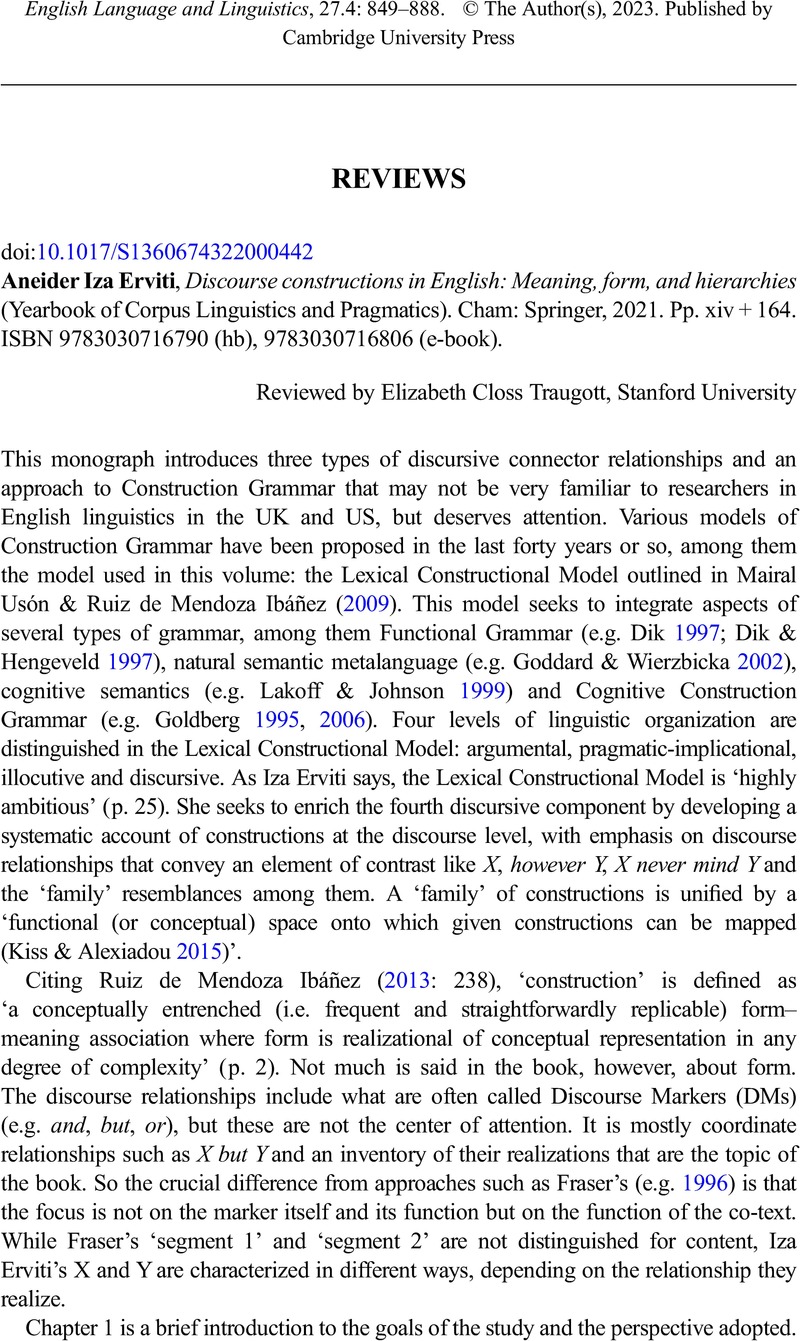No CrossRef data available.
Article contents
Aneider Iza Erviti, Discourse constructions in English: Meaning, form, and hierarchies (Yearbook of Corpus Linguistics and Pragmatics). Cham: Springer, 2021. Pp. xiv + 164. ISBN 9783030716790 (hb), 9783030716806 (e-book).
Review products
Aneider Iza Erviti, Discourse constructions in English: Meaning, form, and hierarchies (Yearbook of Corpus Linguistics and Pragmatics). Cham: Springer, 2021. Pp. xiv + 164. ISBN 9783030716790 (hb), 9783030716806 (e-book).
Published online by Cambridge University Press: 09 March 2023
Abstract
An abstract is not available for this content so a preview has been provided. Please use the Get access link above for information on how to access this content.

Information
- Type
- Book Review
- Information
- Copyright
- Copyright © The Author(s), 2023. Published by Cambridge University Press
References
Dik, Simon C. 1997. The theory of Functional Grammar, part 1: Structure of the clause. Berlin: Mouton de Gruyter.Google Scholar
Dik, Simon C. & Hengeveld, Kees. 1997. The theory of Functional Grammar, part 2: Complex and derived constructions. Berlin: Mouton de Gruyter.CrossRefGoogle Scholar
Fillmore, Charles J., Kay, Paul & O'Connor, Mary Catherine. 1988. Regularity and idiomaticity in grammatical constructions. Language 64, 501–38.CrossRefGoogle Scholar
Goddard, Cliff & Wierzbicka, Anna. 2002. Meaning and universal grammar. Amsterdam: John Benjamins.Google Scholar
Goldberg, Adele E. 1995. Constructions: A Construction Grammar approach to argument structure. Chicago: University of Chicago Press.Google Scholar
Goldberg, Adele E. 2003. Constructions: A new theoretical approach to language. Trends in Cognitive Sciences 7, 219–24.CrossRefGoogle ScholarPubMed
Goldberg, Adele E. 2006. Constructions at work: The nature of generalization in language. Oxford: Oxford University Press.Google Scholar
Kiss, Tibor & Alexiadou, Artemis (eds.). 2015. Syntax – theory and analysis: An international handbook. Berlin: Mouton de Gruyter.Google Scholar
Lakoff, George & Johnson, Mark. 1999. Philosophy in the flesh: The embodied mind and its challenge to Western thought. New York: Basic Books.Google Scholar
Langacker, Ronald W. 1987. Foundations of Cognitive Grammar, vol. 1: Theoretical prerequisites. Stanford: Stanford University Press.Google Scholar
Langacker, Ronald W. 1991. Foundations of Cognitive Grammar, vol. 2: Descriptive application. Stanford: Stanford University Press.Google Scholar
Mairal Usón, Ricardo & Ruiz de Mendoza Ibáñez, Francisco J.. 2009. Levels of description and explanation in meaning construction. In Butler, Christopher S. & Martín Arista, Javier (eds.), Deconstructing constructions, 153–98. Berlin: Mouton de Gruyter.CrossRefGoogle Scholar
Mann, William C. & Thompson, Sandra A.. 1988. Rhetorical Structure Theory: Toward a functional theory of text organization. Text 8(3), 243–81.Google Scholar
Ruiz de Mendoza Ibáñez, Francisco J. 2013. Meaning construction, meaning interpretation and formal expression in the Lexical Constructional Model. In Diedrichsen, Elke & Nolan, Brian (eds.), The role of constructions in grammars. Amsterdam: John Benjamins.Google Scholar
Ruiz de Mendoza Ibáñez, Francisco J. & Ángeles Gómez-González, María de los. 2014. Constructing discourse and discourse constructions. In González, María de los Ángeles Gómez, Ruiz de Mendoza Ibáñez, Francisco J. & Gonzálvez-García, Francisco (eds.), Theory and practice in functional cognitive space, 295–314. Amsterdam: John Benjamins.Google Scholar
Traugott, Elizabeth Closs. 2022. Discourse structuring markers in English: A historical constructionalist perspective on pragmatics. Amsterdam: John Benjamins.CrossRefGoogle Scholar


